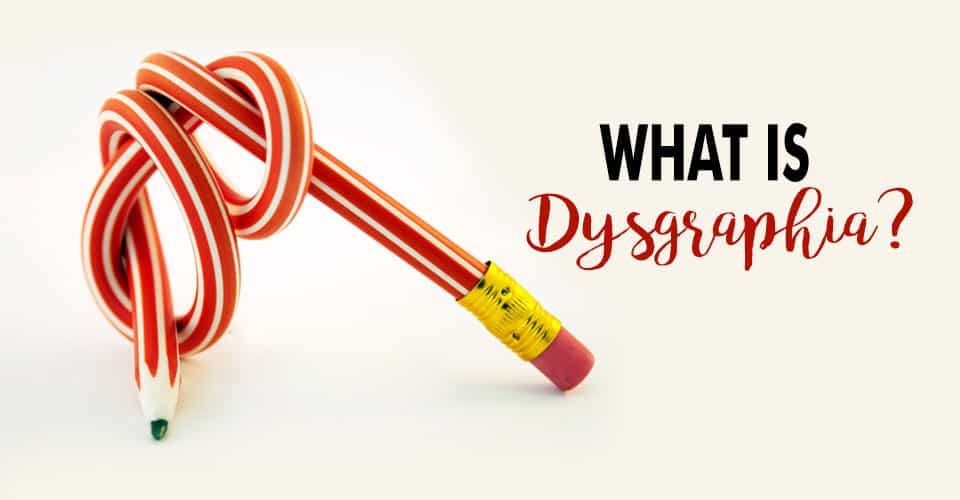Dysgraphia is a neurological disorder affecting the ability of writing. Beyond its academic challenges, dysgraphia can pose mental health risks and worsen adaptive behavior in academic and professional areas of life.
What Is Dysgraphia?
Dysgraphia is a neurological disorder characterized by difficulty in writing or graphing symbols 1 Rocha Cabrero, F., & De Jesus, O. (2023). Dysgraphia. PubMed; StatPearls Publishing. Available from: https://www.ncbi.nlm.nih.gov/books/NBK559301/ , often resulting in unreadable handwriting. The term comes from the Greek words ‘dys’ meaning ‘impaired’ and ‘graphia’ meaning ‘letter forms by hand’.
Dysgraphia, besides being a learning disability, also affects the motor skills involved in writing. Individuals with dysgraphia may struggle with various aspects of writing, including letter formation, spacing between words, organizing thoughts on paper, and maintaining consistent handwriting. It can affect both print and cursive writing.
Symptoms Of Dysgraphia
The common 2 Chung, P. J., Patel, D. R., & Nizami, I. (2020). Disorder of written expression and dysgraphia: definition, diagnosis, and management. Translational pediatrics, 9(Suppl 1), S46–S54. https://doi.org/10.21037/tp.2019.11.01 symptoms of dysgraphia include:
- Unreadable handwriting
- Difficulty with letter formation
- Poor spacing between words
- Inconsistent letter sizing and shape
- Difficulty organizing thoughts on paper
- Poor spelling and punctuation
- Struggles with fine motor skills related to writing
Read More About Types of Dysgraphia Here
What Causes Dysgraphia?
Studies 3 McCloskey, M., & Rapp, B. (2017). Developmental dysgraphia: An overview and framework for research. Cognitive neuropsychology, 34(3-4), 65–82. https://doi.org/10.1080/02643294.2017.1369016 on what causes dysgraphia point to factors like:
- Genetic heritability of the disorder across generations
- Neurological differences in brain structure or function
- Developmental delays in fine motor skills
- Problems with visual-spatial processing (like reading maps or solving puzzles)
- Difficulty with understanding language and communicating back
- Co-occurring conditions such as ADHD or dyslexia 4 Adi-Japha, E., Landau, Y. E., Frenkel, L., Teicher, M., Gross-Tsur, V., & Shalev, R. S. (2007). ADHD and dysgraphia: underlying mechanisms. Cortex; a journal devoted to the study of the nervous system and behavior, 43(6), 700–709. https://doi.org/10.1016/s0010-9452(08)70499-4
Read More About ADHD Here
Mental Health And Dysgraphia
Dysgraphia often intersects with mental health challenges 5 Chung, P. J., Patel, D. R., & Nizami, I. (2020). Disorder of written expression and dysgraphia: definition, diagnosis, and management. Translational pediatrics, 9(Suppl 1), S46–S54. https://doi.org/10.21037/tp.2019.11.01 , amplifying the complexity of both conditions. Individuals with dysgraphia may experience frustration, anxiety, and low self-esteem due to difficulties with handwriting, spelling, and expressing thoughts on paper.
These struggles can contribute to feelings of inadequacy and isolation, exacerbating mental health issues such as depression and anxiety. Additionally, the stress of coping with dysgraphia in academic and social settings can further strain mental well-being.
How To Diagnose Dysgraphia
Measures on how to diagnose dysgraphia involve a comprehensive evaluation process 6 Danna, J., Puyjarinet, F., & Jolly, C. (2023). Tools and Methods for Diagnosing Developmental Dysgraphia in the Digital Age: A State of the Art. Children (Basel, Switzerland), 10(12), 1925. https://doi.org/10.3390/children10121925 that considers both the individual’s writing difficulties and potential underlying causes. Steps in the diagnosis often include a thorough review of medical history, observations of writing samples, standardized tests assessing writing skills, and interviews with the individual and their parents or caregivers to gather information about developmental milestones and academic performance.
Several assessment tools 7 Drotár, P., & Dobeš, M. (2020). Dysgraphia detection through machine learning. Scientific reports, 10(1), 21541. https://doi.org/10.1038/s41598-020-78611-9 are commonly utilized in diagnosing dysgraphia, including standardized tests such as the Test of Written Language (TOWL) and the Wechsler Individual Achievement Test (WIAT). These tests evaluate various aspects of writing skills, including handwriting, spelling, grammar, and composition. Additionally, informal assessments may involve analyzing writing samples for specific errors and observing the individual’s writing process to check signs of difficulty or frustration.
Treatment Of Dysgraphia
Treatment of dysgraphia may involve a combination 8 Devi, A., & Kavya, G. (2023). Dysgraphia disorder forecasting and classification technique using intelligent deep learning approaches. Progress in neuro-psychopharmacology & biological psychiatry, 120, 110647. https://doi.org/10.1016/j.pnpbp.2022.110647 of dysgraphia therapy and specialized training techniques aimed at addressing both the cognitive and motor aspects of writing difficulties:
- Cognitive-behavioral therapy (CBT) can help individuals manage the emotional challenges associated with dysgraphia, such as frustration, anxiety, and low self-esteem.
- Occupational therapy focuses on improving fine motor skills and handwriting proficiency through exercises targeting hand-eye coordination, grip strength, and pencil control.
- Multi-sensory instruction techniques, such as the Orton-Gillingham approach, incorporate visual, auditory, and kinesthetic learning modalities to reinforce letter formation, spelling, and composition skills.
- Assistive technology tools, such as speech-to-text software and specialized writing aids, can facilitate communication and expression for individuals with severe dysgraphia, allowing them to bypass handwriting challenges and focus on content creation.
Read More About Cognitive-behavioral therapy (CBT) Here
Self-help Tips For Managing Dysgraphia In Adults
Consider the following self-help tips 9 Deuel R. K. (1995). Developmental dysgraphia and motor skills disorders. Journal of child neurology, 10 Suppl 1, S6–S8. https://doi.org/10.1177/08830738950100S103 for managing the symptoms of dysgraphia:
- Utilize assistive technology such as voice-to-text software or word prediction tools to bypass handwriting challenges.
- Break down writing tasks into manageable steps to reduce overwhelm and improve focus.
- Practice handwriting exercises regularly to improve fine motor skills and letter formation.
- Use organizational tools like planners or digital calendars to stay organized with assignments and deadlines.
- Implement relaxation techniques such as deep breathing or mindfulness to manage stress and anxiety related to writing.
- Advocate for yourself by communicating your needs to teachers, employers, and peers, and seeking appropriate accommodations.
- Explore alternative methods of expression, such as drawing, typing, or dictating ideas aloud, to convey thoughts and ideas effectively.
- Seek support from friends, family, and professionals, such as occupational therapists or counselors, to address emotional challenges and develop coping strategies.
- Celebrate progress and achievements, no matter how small, to maintain motivation and confidence in managing dysgraphia effectively.
Parenting Tips For Children With Dysgraphia
Parenting a child with dysgraphia can present unique challenges, as this specific learning disability 10 Finardi, G., Paleari, F. G., & Fincham, F. D. (2022). Parenting a Child with Learning Disabilities: Mothers’ Self-Forgiveness, Well-Being, and Parental Behaviors. Journal of Child and Family Studies. https://doi.org/10.1007/s10826-022-02395-x affects their ability to write and express themselves effectively. However, with patience, understanding, and proactive support, parents can play a crucial role in helping their child navigate these difficulties. Strategies like fostering a positive learning environment to advocating for necessary accommodation can help children with dysgraphia thrive both academically and emotionally.
Read More About Parenting Here
Recovery From Dysgraphia
Recovery from dysgraphia is a continuous journey 11 Rocha Cabrero, F., & De Jesus, O. (2023). Dysgraphia. PubMed; StatPearls Publishing. Available from: https://www.ncbi.nlm.nih.gov/books/NBK559301/ that involves ongoing support, practice, and adaptation to individual needs. While dysgraphia may not be “cured” in the traditional sense, individuals can make significant progress in managing their writing difficulties and improving overall functional abilities.
Management of dysgraphia involves a collaborative approach involving educators, therapists, and caregivers to provide ongoing support and reinforcement of skills. Regular monitoring of progress, adjustments to interventions based on individual needs, and fostering a positive learning environment are essential components of successful management. With patience, perseverance, and the right support system in place, individuals with dysgraphia can thrive academically, socially, and personally, achieving their full potential despite the challenges posed by the condition.
Takeaway
Addressing dysgraphia as a mental health wellbeing requirement necessitates comprehensive support systems, including specialized interventions, assistive technologies, and emotional support. By recognizing dysgraphia’s impact on individuals’ mental well-being and implementing effective strategies to manage its challenges, we can foster resilience, confidence, and overall well-being in those affected by this learning disability.
At A Glance
- Dysgraphia is a neurological disorder affecting writing ability.
- Symptoms of dysgraphia involve illegible handwriting and difficulty organizing thoughts on paper.
- Research on what causes dysgraphia points to genetics, neurological differences, and developmental delays.
- Dysgraphia in adults and children come with mental health challenges such as frustration and anxiety.
- Measures on how to diagnose dysgraphia involve a comprehensive evaluation process, including standardized tests and observations.
- Treatment of dysgraphia typically includes a combination of dysgraphia therapy and specialized training techniques.
- Recovery from dysgraphia is a continuous journey requiring patience, perseverance, and self-care.
Frequently Asked Questions (FAQs)
1. Does Dysgraphia Affect Memory?
Dysgraphia can affect memory indirectly by making it challenging to recall information due to difficulties in writing.
2. What Are The Limitations Of Dysgraphia?
The limitations of dysgraphia include impaired handwriting, spelling, and organization skills.
3. Does Dysgraphia Affect Typing?
Dysgraphia may impact typing due to similar difficulties in motor coordination and language processing.
4. Can Dysgraphia Cause Pain?
Yes, dysgraphia can cause pain due to the physical strain associated with writing tasks.















